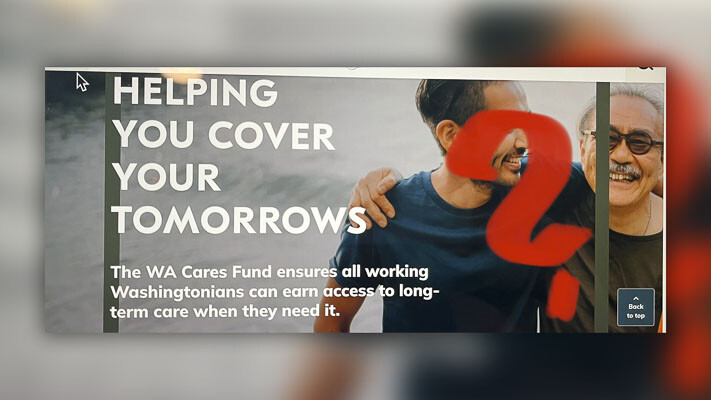
Elizabeth Hovde of the Washington Policy Center provides some of the meeting’s highlights
Elizabeth Hovde
Washington Policy Center
The state has spent a lot of money on its fund for long-term care already, and it still only promises a small benefit to some workers. That was my takeaway from today’s Long-Term Services and Supports Trust Commission Investment Strategy Subcommittee meeting, available on TVW. Here are some of the meeting’s highlights, after people were reminded what WA Cares is and isn’t and that Washington’s W-2 workers will be taxed 58 cents for every $100 they make starting in July.

The good-ish: The state’s investment board is ready to invest the money it starts receiving this fall. While workers start seeing the WA Cares payroll tax chomping at their checks in July, the money taken from them for this state fund does some twists and turns before landing in the board’s lap.
The WA Cares fund should have a strong start, the subcommittee was told. Workers will be paying in about $900 million each year and benefits won’t start going out for three years. This funding plan was made after the state’s unfortunate experience with its Paid Family and Medical Leave social program. That program was seeing red, needing cash-flow help from the Legislature and an increased tax rate.
The bad: An estimated $52 million has already been spent before the program begins. It needs to be paid back, said an agency spokesperson when explaining what will be happening to the money when it starts rolling in.
I’m surprised that figure isn’t even higher, given the number of ads I hear trying to convince people they will love WA Cares. What those ads don’t say, by the way, is that many workers will not see a return on investment.
The ugly: I’ve viewed the remade WA Cares website that launched this week. While the site wasn’t discussed, it was mentioned and is presented as an achievement in the WA Cares communication efforts. I think it’s off-target and misleading — again.
From the get-go, messaging on the site says: “Helping you cover your tomorrows: The WA Cares Fund ensures all working Washingtonians can earn access to long-term care when they need it.” That’s not true. For example, if a worker moves out of state in retirement and then ends up needing long-term care, he does not receive a benefit from WA Cares. Workers also need to meet vestment and health care qualifications they might not.
How the state keeps getting its messaging so wrong is perplexing — and dangerous. The last thing the state and taxpayers need, especially since we have a Medicaid system that gets abused, is more people not saving for life’s needs.
If people are looking through all the website’s pages, the state’s messaging is better at letting on that WA Cares is a social program, not necessarily an individual investment. However, it still insists that the program offers “peace of mind.” It does no such thing. It does offer false security.
Again, not only will many workers be denied the “up to” $36,500 benefit attached to WA Cares for various reasons, that amount of money is inadequate for most people’s long-term-care needs.
The state’s messaging also still commits a big sin of omission: clarity that WA Cares takes money from low-income workers to sometimes benefit those with high incomes and ample resources. This social program creates a safety net for people in need and those not in need. That’s a backward social program. And Medicaid is already a safety net taxpayers provide for people who need long-term care but haven’t the means to pay for it.
Side note: It is clearer and clearer to people learning about WA Cares that it is a jobs program that will benefit Service Employees International Union 775. While WA Cares benefit dollars can pay a caregiver, even a family caregiver, he or she first needs to have training and association with SEIU 775. WA Cares will be working with Consumer Direct Care Network, which explains that required training “is done through SEIU 775 Benefits Group.”
A beneficiary won’t just be handed money to pay a caregiver of his or her choice. The person will need to seek a qualification and be approved by the state. The WA Cares website describes the steps for becoming a paid family caregiver. The allowance is ripe for abuse at taxpayers’ expense. Even if it doesn’t get abused, state taxpayers, some with low means, shouldn’t be paying other families for their caregiving needs in the first place.
The next meeting for this group is in October. Washingtonians will have seen their decreased paychecks by then. For information about future meetings related to WA Cares, visit the Long-Term Services and Support Trust Commission website.
Elizabeth Hovde is a policy analyst and the director of the Centers for Health Care and Worker Rights at the Washington Policy Center. She is a Clark County resident.
Also read:
- Opinion: Not guilty verdict appropriate resolution in case of VPD officerClark County Today Editor Ken Vance offers his praise to the jury in the trial of Vancouver Police Officer Andrea Mendoza.
- Opinion: Union greed closed schools in Port AngelesLiv Finne of the Washington Policy Center offers a recent example to remind others that strikes by public school employees are illegal under state law.
- Opinion: Earth Day 2024 – Time to admit that government-run environmentalism is failingTodd Myers of the Washington Policy Center says that much of what we hear on Earth Day and throughout the year regarding the environment will continue to be mere puffery.
- Opinion: Where do we go from here at Ridgefield School District?When it comes to the Ridgefield School District bond proposal, Heidi Pozzo believes the message should be clear: people are unhappy their perspective is not being heard and considered.
- Letter: Officer Mendoza stood up for public safetyClark County Public Safety Alliance Co-Founder Ann Donnelly provides context of support for Officer Andrea Mendoza.










